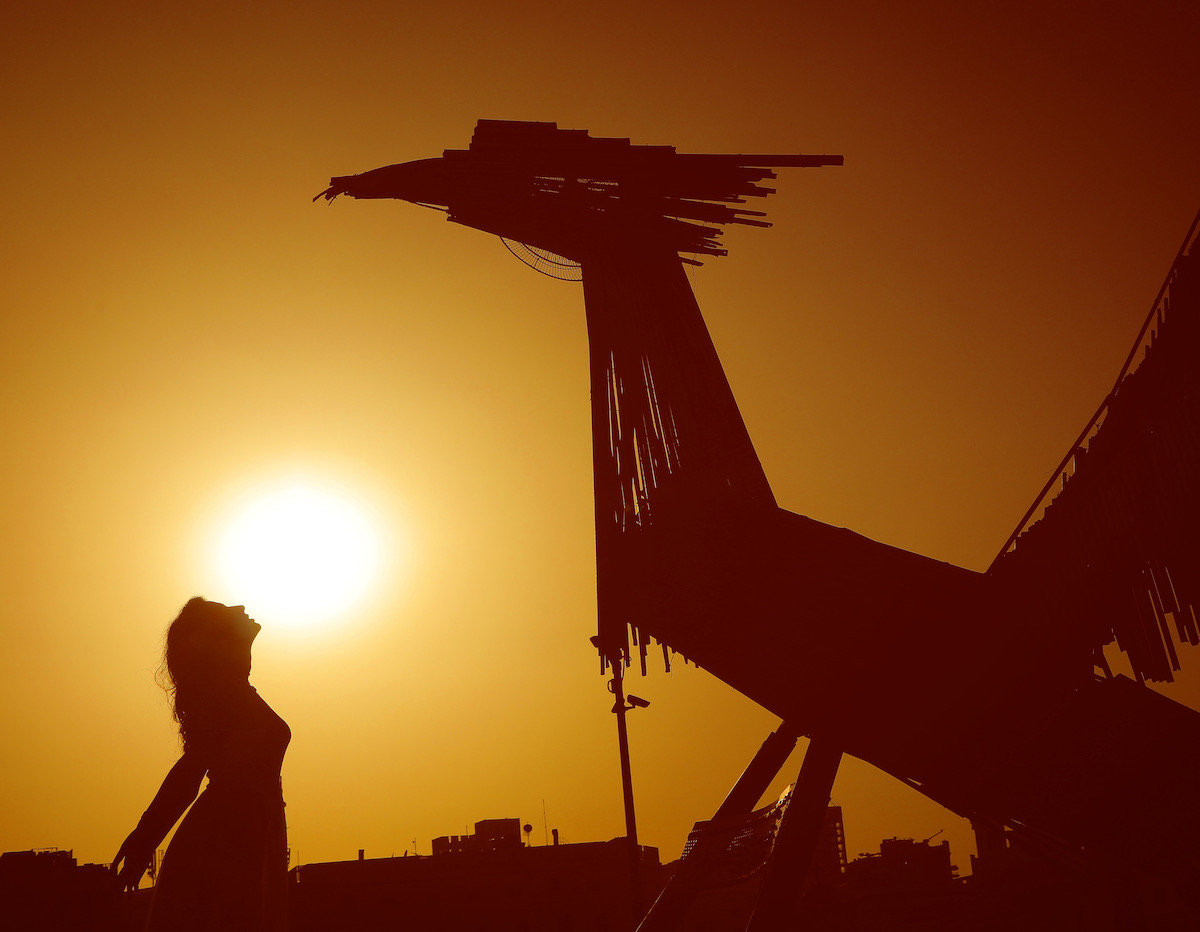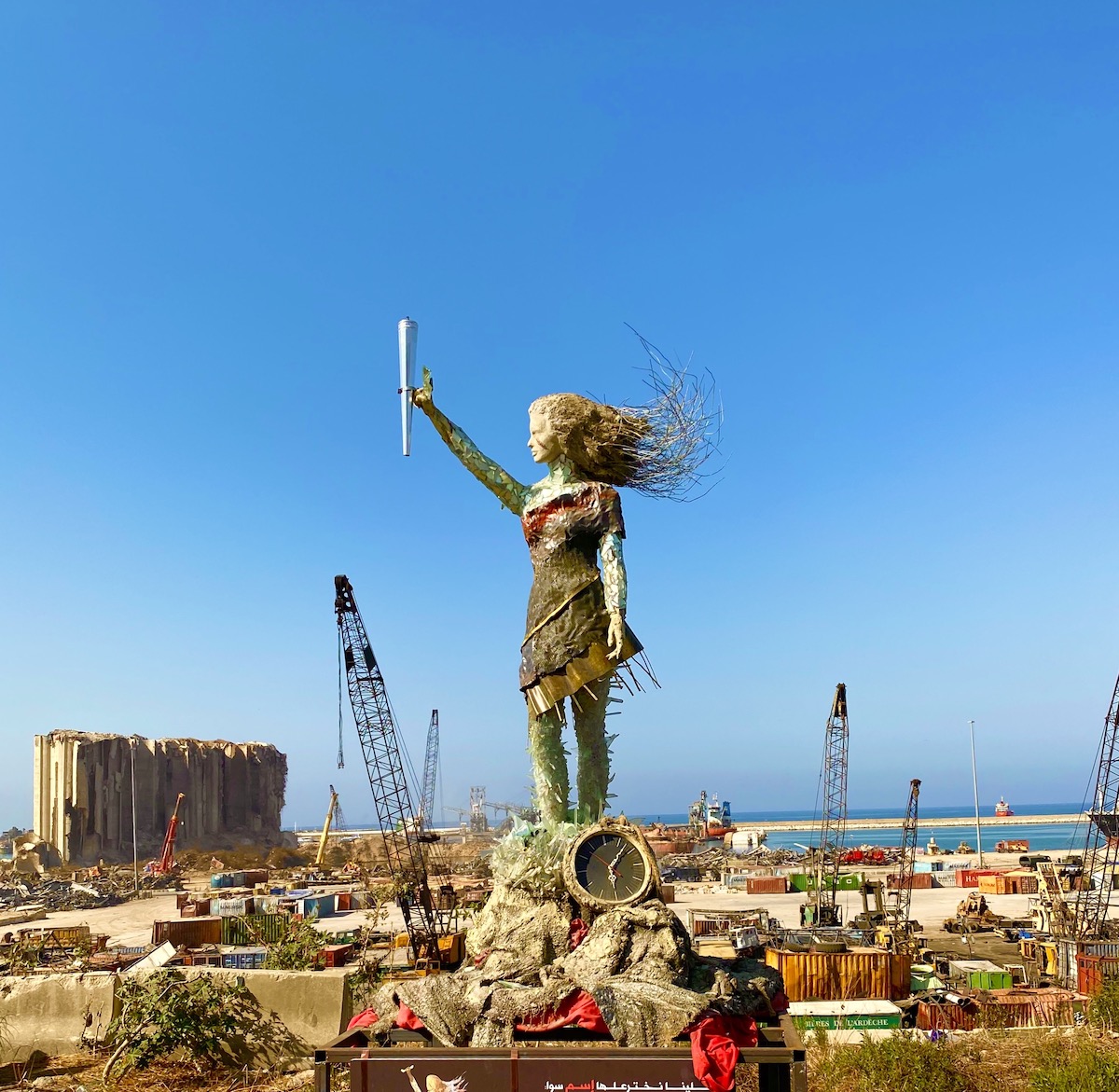Though several of her sculptures, all made with upcycled materials, were destroyed by pro-government activists, Nazer was not deterred. In fact, her desire to create art that speaks to the masses only grew and has culminated with this untitled sculpture of a woman proudly standing at the port. Though the sculpture has now been moved for fear that it will be destroyed, Nazer is hopeful that with proper funding she’ll be able to create a larger, permanent memorial, to all those who were lost or injured in the explosion.
We had a chance to chat with the Lebanese artist about what motivated her to create this revolutionary art and the symbolism behind this powerful sculpture. Read on for My Modern Met’s exclusive interview.
 What drove you to begin creating these sculptures?I used to work with the United Nations, then I quit my job to be an artist because I felt the need—it was not the want, but the need—to paint and to do art. So I quit my job around 2016 or 2017. I started painting, and I sold a few paintings in several countries. Then during the Revolution, I went to the streets on the first day, and we did all that we could, but then I felt that I needed to express more, to do more. And the best way for me to express is through art.
What drove you to begin creating these sculptures?I used to work with the United Nations, then I quit my job to be an artist because I felt the need—it was not the want, but the need—to paint and to do art. So I quit my job around 2016 or 2017. I started painting, and I sold a few paintings in several countries. Then during the Revolution, I went to the streets on the first day, and we did all that we could, but then I felt that I needed to express more, to do more. And the best way for me to express is through art.
I saw some guys, some pro-government protesters, they came and they broke our tents—the protester’s tents—in Martyrs Square. And people had put the broken tents under the Fist of the Revolution. So I got the idea to create a phoenix out of the broken tents because I could not see broken things related to the Revolution. I did not want them to break us. And I wanted to fight back through art. And I hadn’t done any sculpture ever in my life before. I did not know how to do it, but I so wanted to do it.
 (continued) Then, on the Day of Independence, I woke up and I saw that some pro-government people came and burnt the Fist of the Revolution because they want to end our revolution. So I said to myself, today the phoenix should be born and it will rise and I went to the street and when I went to Martyrs Square and I started removing the metal. Then people—because it was Independence Day and it was a day off—who had come from all over Lebanon to participate in an event to protest started asking me, why are you removing the metal? What are you going to do? I told them that I wanted to build a phoenix out of it because a phoenix is a bird that every time they burn it, it will rise again from its own ashes. Then suddenly, people started helping me build the Phoenix—old, young, children, women, men from all over Lebanon. All religions, sects, all areas, hand in hand, they were helping me without knowing each other’s names.
(continued) Then, on the Day of Independence, I woke up and I saw that some pro-government people came and burnt the Fist of the Revolution because they want to end our revolution. So I said to myself, today the phoenix should be born and it will rise and I went to the street and when I went to Martyrs Square and I started removing the metal. Then people—because it was Independence Day and it was a day off—who had come from all over Lebanon to participate in an event to protest started asking me, why are you removing the metal? What are you going to do? I told them that I wanted to build a phoenix out of it because a phoenix is a bird that every time they burn it, it will rise again from its own ashes. Then suddenly, people started helping me build the Phoenix—old, young, children, women, men from all over Lebanon. All religions, sects, all areas, hand in hand, they were helping me without knowing each other’s names.
We built the Phoenix together and it became a huge symbol of the Revolution. It got a lot of attention and media coverage and everyone was taking pictures next to it—even tourists came to Lebanon to participate in the Revolution and to take pictures of the Phoenix. But a few days ago, those pro-government people broke and burnt the Phoenix. They broke its wings and stole the head of the Phoenix, which broke my heart, actually. That was the first sculpture I’ve ever done. Lots of people cried while we were building it because it was very emotional and lots of people cried and called me when it got broken.

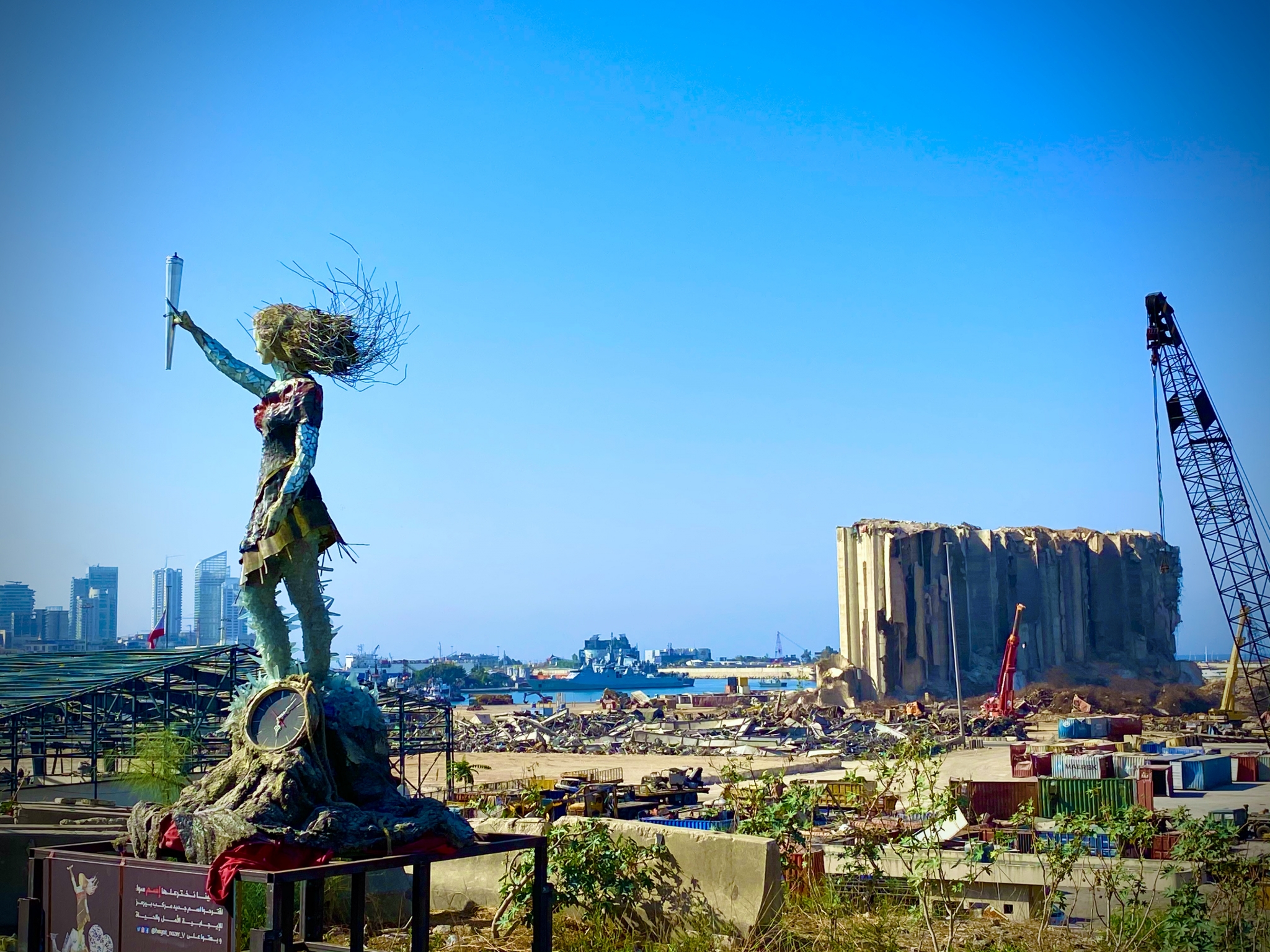 How did you go about gathering the material to create the port sculpture?The explosion happened and I stopped everything. I went to the streets and I started bringing mattresses, tents, food, everything that I could gather to help people who got affected by the explosion. And that’s what I did at the beginning. Then we started cleaning people’s houses and the streets so that people could go back to their homes because the houses were filled with shattered glass, broken furniture, and everything. So I asked for volunteers on my Instagram. Lots of people joined me and we went and cleaned houses, and I did not want to throw away the rubble. I packed it in bags, and I took it with me to my house which is also my workshop.
How did you go about gathering the material to create the port sculpture?The explosion happened and I stopped everything. I went to the streets and I started bringing mattresses, tents, food, everything that I could gather to help people who got affected by the explosion. And that’s what I did at the beginning. Then we started cleaning people’s houses and the streets so that people could go back to their homes because the houses were filled with shattered glass, broken furniture, and everything. So I asked for volunteers on my Instagram. Lots of people joined me and we went and cleaned houses, and I did not want to throw away the rubble. I packed it in bags, and I took it with me to my house which is also my workshop.
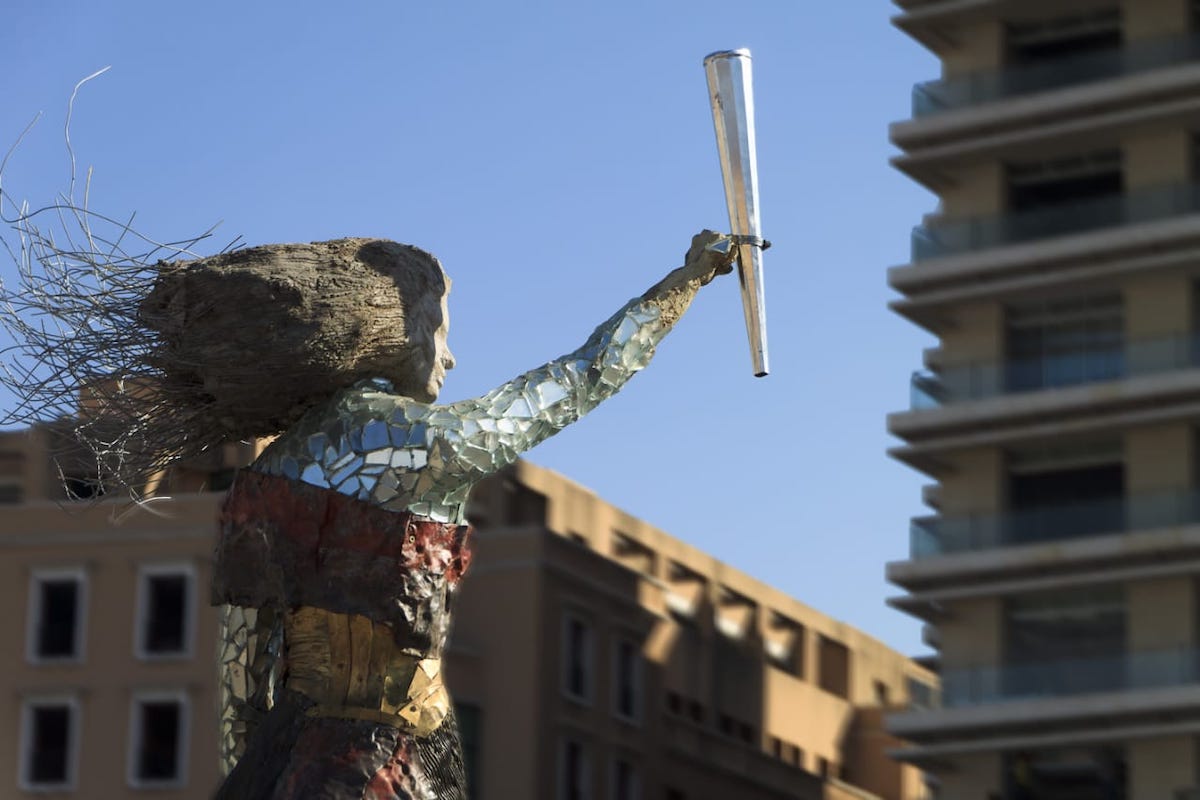 Can you describe some of the items that went into making her?I had started a sculpture of a woman before the explosion. I did not know why I was doing it. But I was. Sometimes I don’t know why I do projects. And then, after I do them, I discover why I’m doing them. And, you know, Beirut has been destroyed so many times. It’s not the first time so I felt that the struggle should be part of the creation of the sculpture of the woman and I felt that Beirut is a woman. And to so many people, Beirut is a woman, and she’s a beautiful woman.
Can you describe some of the items that went into making her?I had started a sculpture of a woman before the explosion. I did not know why I was doing it. But I was. Sometimes I don’t know why I do projects. And then, after I do them, I discover why I’m doing them. And, you know, Beirut has been destroyed so many times. It’s not the first time so I felt that the struggle should be part of the creation of the sculpture of the woman and I felt that Beirut is a woman. And to so many people, Beirut is a woman, and she’s a beautiful woman.
So I started creating the sculpture made out of the rubble. I wanted her to look beautiful because Beirut is beautiful, but she had to show the pain of those who died and of those who got injured. There was a thin line between making her look beautiful because Beirut is beautiful. Beirut is so beautiful, that everyone wants a piece of Beirut. And that’s what happens when a woman is so beautiful and everyone wants her and it hurts her sometimes and that’s what happened to Beirut. If you see her face, it’s injured; her legs are made out of broken glass, her dress is made out of broken metal and copper that I also found. It’s all upcycled. There are also broken mirrors that reflect the light.
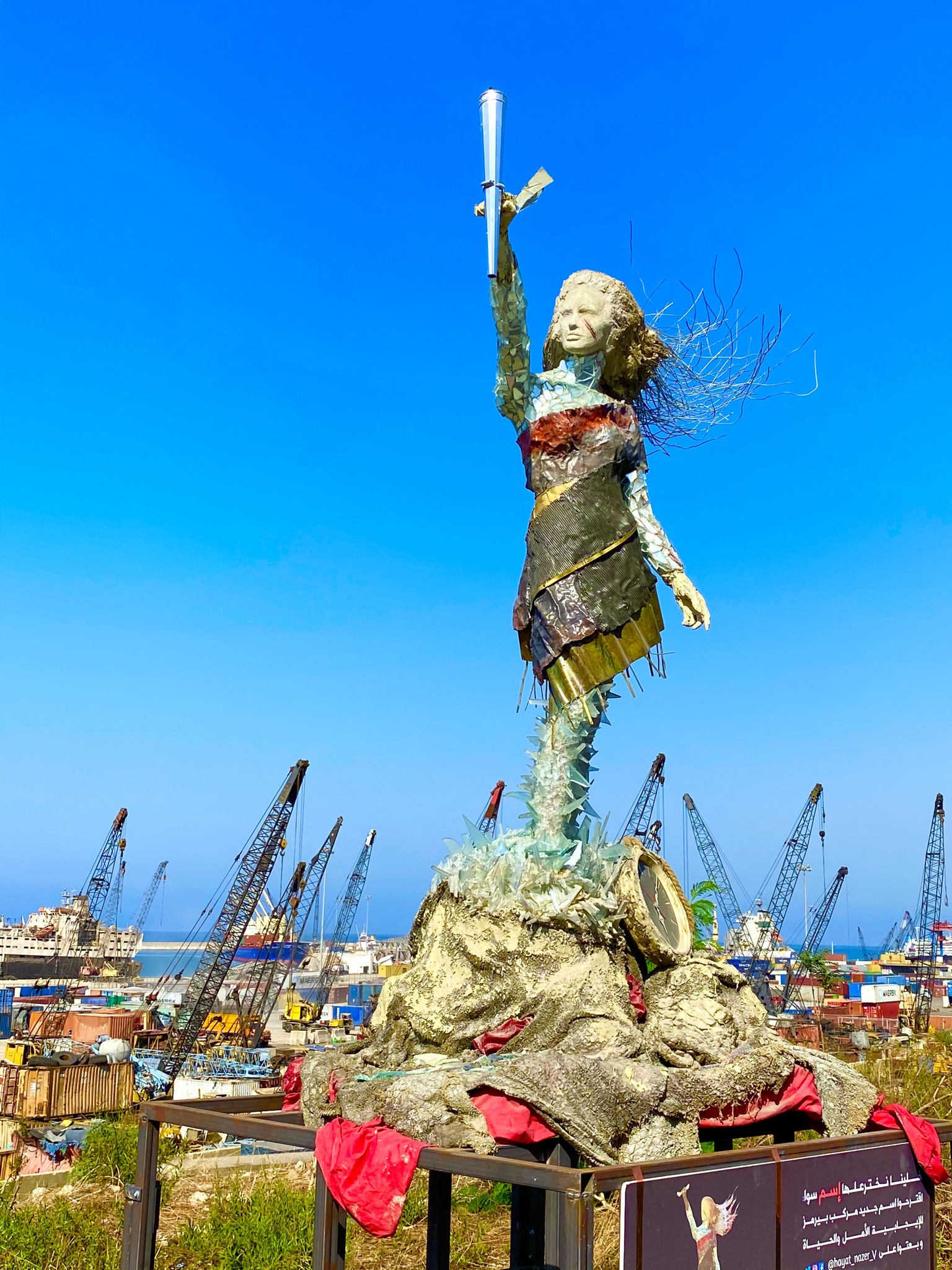 Can you describe the sculpture in your own words and your thought process in the composition?
Can you describe the sculpture in your own words and your thought process in the composition?
I kept one hand down. She’s too tired, this hand is too tired to even be lifted. And her legs are just standing still as if she doesn’t want to move. The hair looks as if it’s still flowing in the air. And, you know, when the explosion happened there was a lot of force and pressure from the air. So I wanted her hair to feel as if the explosion is still happening. Underneath all of that on the right, there’s the broken clock that I found in the streets and it had stopped at 6:08 or 6:07, which was the time of the explosion.
I included it in the sculpture because so many of us feel like we cannot move on. We are still stuck in time at the time of the explosion, we are not over it, we are still traumatized. And this part expresses the pain that we are going through and the trauma that we are going through. On the left, you see the hand is lifted because she wants to rise, she wants to continue to rise again, she wants strength. Also the leg on the left. If you see it, it’s a bit bent as if she’s just about to walk—she just was about to move to rise. And this is what I wanted to show. It’s reality. We want to rise, but we are in pain.
At first, I made her carry a broken mirror in the shape of a V because I wanted people to see themselves in the reflection. But unfortunately, while moving the statue to the port, the mirror in her hand broke. On October 17 people were carrying torches from all over Lebanon to light a big torch and so I also made her carry one. So first there was a broken mirror and then she was carrying a torch and then I had to remove the torch from her hand on the day of the first anniversary of the Revolution. During that event, I took the torch, which represented the torch carried by people from all over Lebanon, from her hand and used it to light a huge torch which is also at the port.
She was lighting the torch of the Revolution. When I removed the torch, her hand was empty. Someone came and asked me if he could put the Lebanese flag in her hand, and so we made her carry the Lebanese flag. The next day, because of the wind, the flag flew away. So she was left with the wooden stick and looks like she is carrying a sword. So in some pictures, you see her carrying a sword, in some pictures a torch, in some a flag, and some just a mirror. I love that it’s interactive.
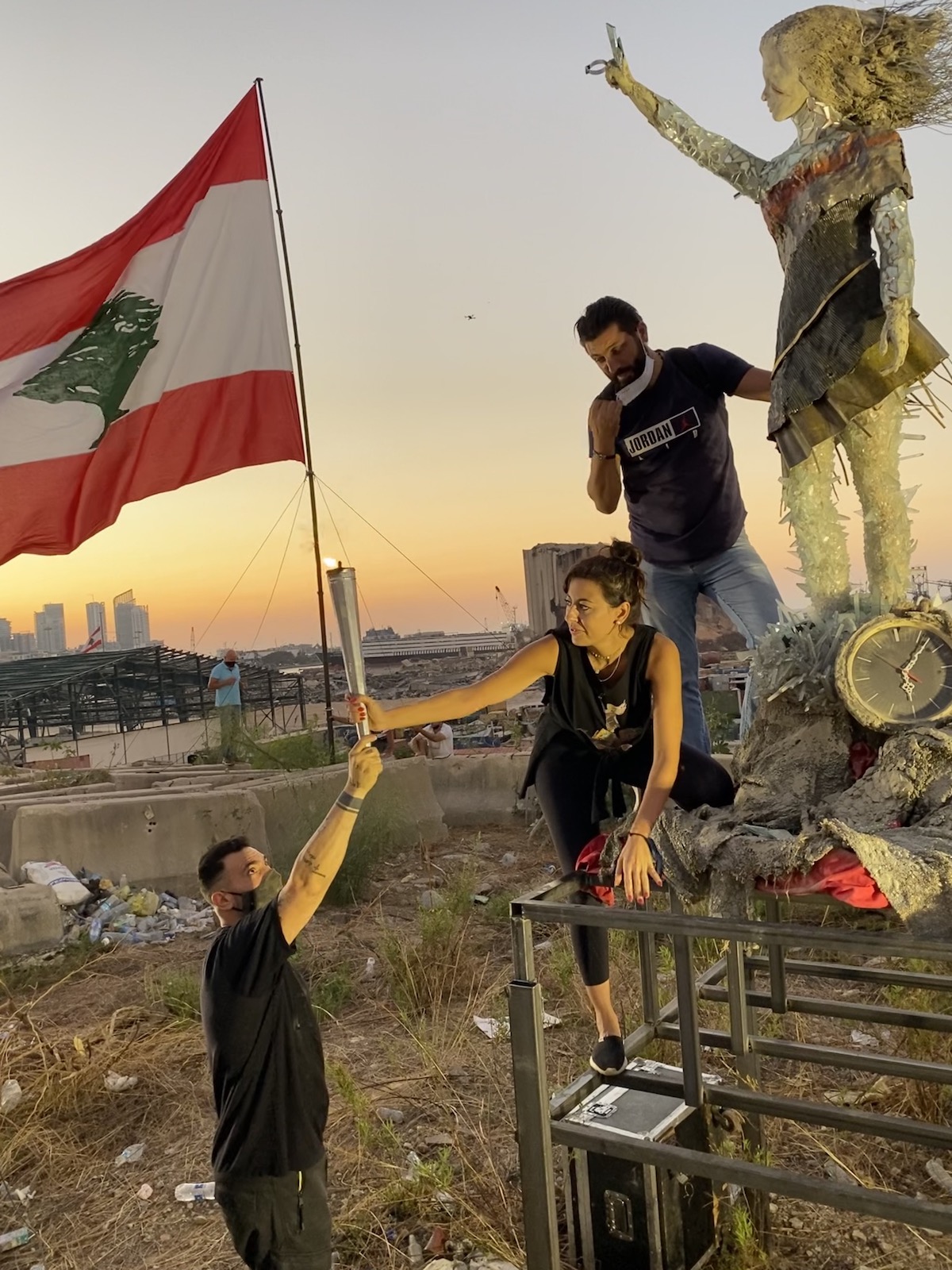 What was the reaction of people to the artwork?
What was the reaction of people to the artwork?
So many people have contacted me—those who lost people in the explosion, the families who lost their mothers or their children, some who have the same injury on their faces, they contacted me and they told me they cried. When they saw this sculpture, they told me that they were not able to express how they feel on the inside. Sometimes words cannot express a feeling that is so deep and enormous on the inside and they told me that this sculpture represents exactly how they feel. It was very emotional for them.
 Because the Phoenix was burned, you’ve decided to move this sculpture to protect it. Can you talk a bit about that?
Because the Phoenix was burned, you’ve decided to move this sculpture to protect it. Can you talk a bit about that?
A few days ago, some people came and burned and broke the Phoenix. People were very worried that someone would break her, because she now represents the people and their pain and their dreams and everything. So I had to remove her from the port. But my plan, and what people actually want, is to create a replica of her—a huge one. This one is a little less than three meters tall. What we wish to do is to create a huge replica that would last, that would serve as a memorial for everyone who died and for everyone who got injured—physically and emotionally and psychologically. And for that, I need to raise funds to create a long-lasting sculpture that represents the first biggest explosion—nonnuclear explosion—in the world, and the third biggest in the world.
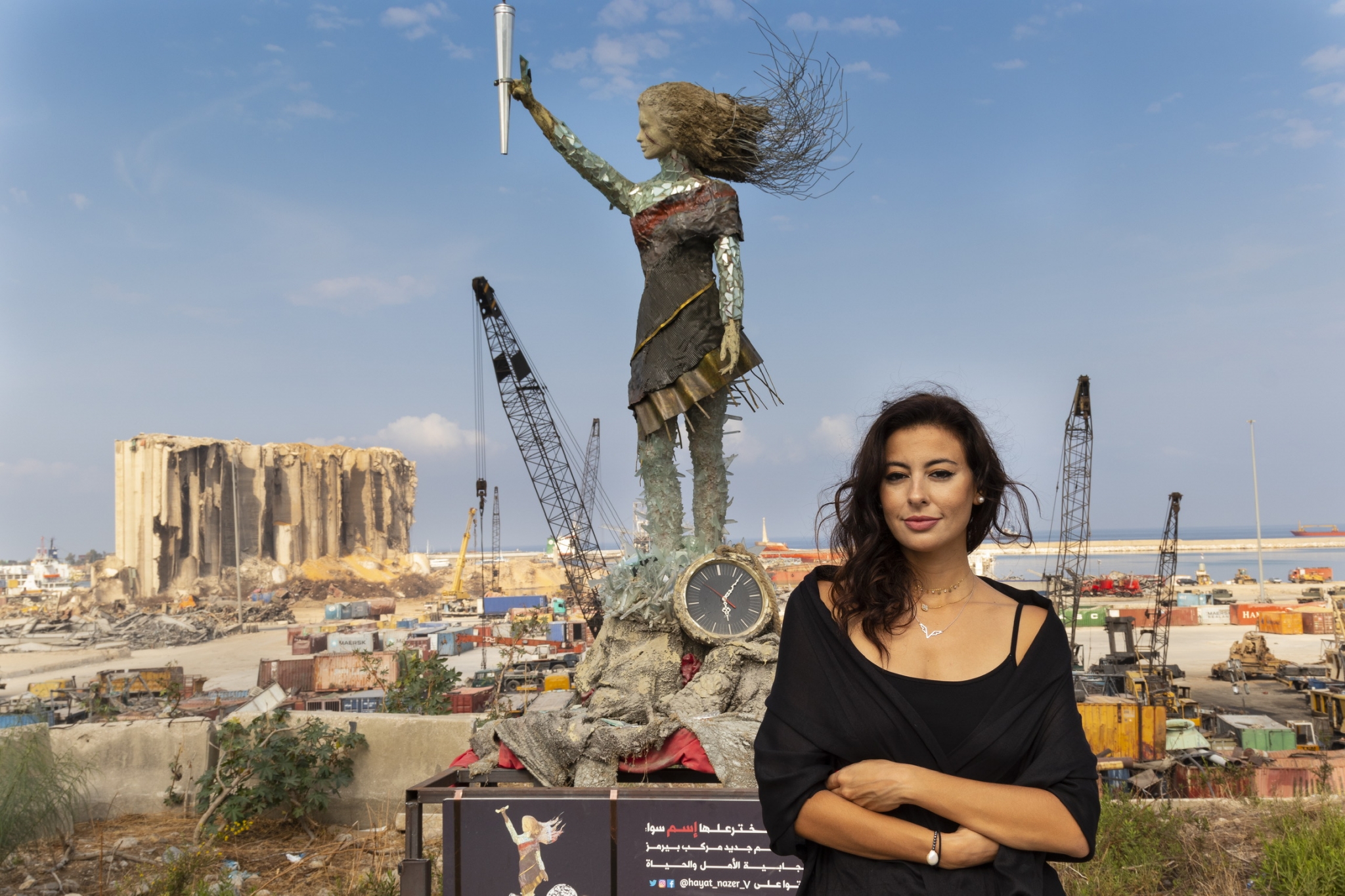 What do you hope that people in Lebanon and beyond take away from your work?
What do you hope that people in Lebanon and beyond take away from your work?
I am an artist and even I did not know the effect and the importance of art before the Revolution. I loved art, but I used to feel that I cannot make a change through art and I’m someone who believes that we have a life purpose and we need to make a change in this world. I’m driven by positive change and I felt that through art I was not going to be able to do that. But during this Revolution, it actually changed my life.
So when I started, many people questioned me. They said, it’s just art, let’s go and do better things like blocking the roads and all of that. Some people—very few—were like, oh, it means nothing. You know, it’s just art. How is it going to make a change? But then they saw international media filming and they saw how we were able to deliver our message all over the world through art. They were like, okay, you were right about doing the sculpture. And then, when the government sent people to remove all the tents from Martyrs Square because of COVID-19, the only thing that stayed was the artwork. And these same people, they called me and told me they were wrong. It’s the only thing that stays, that is still shouting revolution.
And some of the protesters who never even knew anything about art or who did not care about art, they were the ones who helped me build it, who kept on protecting the Phoenix. I received calls from people who never cared about art, they were like, let’s build it again, we can not let them break us. We are ready, whenever you want. They are the ones who take pictures. And they send me pictures of themselves cleaning around the Phoenix, although it’s broken, but they are cleaning and trying to fix it. These are the people who never knew anything about art or industry. Now, through art, they were touched.
